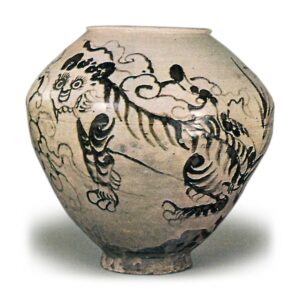
A jar for storing water. The word is found in the Engishiki (Engi Shiki) (Vol. 24, No. 5), which lists the five tribute items for the Kinai region. There are several types of jars, such as “Dai” and “Oyama,” and they are also called “kame” (かめ).
The “Wamayasho” (Japanese text only) notes the following for lacquerware: “Jars are used for drinking from various urns,” and the “Yangji Hanwasho” for tileware: “Crucibles are jars made of wood and tiles. It seems that there was no strict distinction between “壺” and ” crucible” in the ancient system. According to Arai Shiraishi, “The word tsubo is used in ancient times to refer to the circular shape of an object, and the word tsubo is used to refer to the circular shape of an object. The word “tsubu” is also used to refer to a jar, as in the Chronicles of Japan. All vessels with rounded bodies and hollow mouths are called jars. They are made of lacquerware, ceramics, metal, and other materials, and have been used for a variety of purposes in every country since ancient times.



